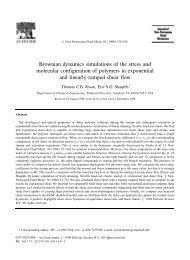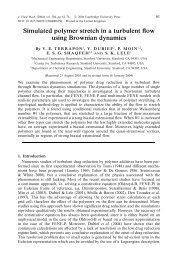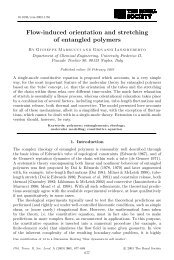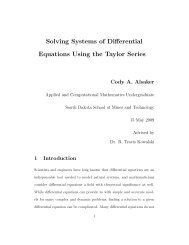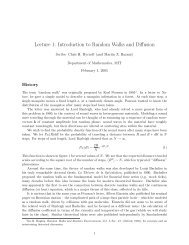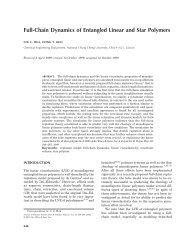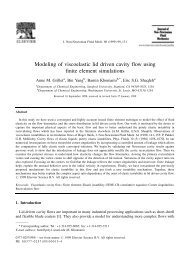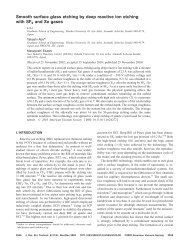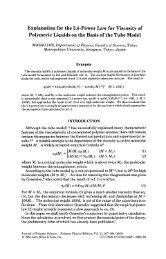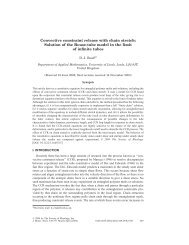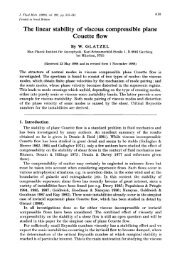A numerical study of the rheological properties of suspensions of ...
A numerical study of the rheological properties of suspensions of ...
A numerical study of the rheological properties of suspensions of ...
You also want an ePaper? Increase the reach of your titles
YUMPU automatically turns print PDFs into web optimized ePapers that Google loves.
176 M. B. Mackaplow and E. S. G. ShaqfehBayram (1990) noted <strong>the</strong> severity <strong>of</strong> <strong>the</strong> instability for each experiment performed,we have only compared our simulations to <strong>the</strong>ir experiments for regular jets. Thisprobably accounts for <strong>the</strong> generally better agreement between <strong>the</strong>ir experimental dataand our simulations as compared to <strong>the</strong> experimental data from o<strong>the</strong>r investigators.O<strong>the</strong>r probable sources <strong>of</strong> <strong>the</strong> discrepancy between experiment and simulations are :(i) incomplete alignment and dispersion <strong>of</strong> fibres, (ii) jamming <strong>of</strong> <strong>the</strong> extrusion orificeby fibres, (iii) polydispersity <strong>of</strong> fibre aspect ratios, and (iv) <strong>the</strong> jet diameter being <strong>of</strong><strong>the</strong> same order as <strong>the</strong> average interfibre spacing. These are discussed in more detailby Pittman & Bayram (1990).5.2.2. Isotropic jibres in shear $owBibbo (1987) measured <strong>the</strong> time evolution <strong>of</strong> <strong>the</strong> shear viscosity in an initiallyisotropic fibre suspension using <strong>the</strong> cup-and-plate rheometer. This device consists <strong>of</strong>a cylindrical cup with a force transducer on <strong>the</strong> bottom and a rotating plate on <strong>the</strong>top. The zero strain (i.e. time=O) measurements correspond to an isotropic suspension.This is because before <strong>the</strong> onset <strong>of</strong> flow <strong>the</strong> <strong>suspensions</strong> were isotropic. This wasevinced by transient measurements <strong>of</strong> <strong>the</strong> shear viscosity and <strong>the</strong> normal stress in <strong>the</strong>suspension and a comparison <strong>of</strong> <strong>the</strong>se values to <strong>the</strong> same transient measurements in<strong>suspensions</strong> with known orientation distributions. We shall be concerned with <strong>the</strong>shear viscosity, which is proportional to <strong>the</strong> rsro component <strong>of</strong> <strong>the</strong> stress tensor, wherer and 0 are <strong>the</strong> radial and flow directions, respectively.Since we compare <strong>the</strong>se experimental results to <strong>the</strong> predictions <strong>of</strong> both <strong>the</strong>ory andsimulations for fibres in planar shear flows, <strong>the</strong> limitations <strong>of</strong> such a comparisonshould be mentioned. First, since <strong>the</strong> radius <strong>of</strong> <strong>the</strong> cup is <strong>of</strong> <strong>the</strong> same order as <strong>the</strong>length <strong>of</strong> <strong>the</strong> fibres, <strong>the</strong> fibres experience a non-homogeneous velocity pr<strong>of</strong>ile. Additionally,since <strong>the</strong> radius and height <strong>of</strong> <strong>the</strong> vessel are <strong>of</strong> <strong>the</strong> same order, <strong>the</strong> ‘edge effects’on <strong>the</strong> velocity pr<strong>of</strong>ile at <strong>the</strong> inner radial wall <strong>of</strong> <strong>the</strong> vessel might not be negligible.There is one o<strong>the</strong>r experimental consideration that one might initially consider tobe important, but is not. If we consider a cylindrical coordinate system (z, 8, r) withits origin at <strong>the</strong> centre <strong>of</strong> <strong>the</strong> cup base, neglecting edge effects <strong>the</strong> velocity field in <strong>the</strong>rheometer iswhere LL) is <strong>the</strong> angular velocity <strong>of</strong> <strong>the</strong> rotating plate, and H and R are <strong>the</strong> heightand radius <strong>of</strong> <strong>the</strong> cup, respectively. Converting to a local Cartesian coordinate systemcentred at any fibre where 1, 2, and 3 are <strong>the</strong> axial, flow, and radial directions,respectively, we see that unlike a cone-and-plate rheometer that induces shear onlyin <strong>the</strong> (1,2)-plane,~ v ~ ( x ) / ~ x> I 0, d ~ 2 ( ~ ) / = d ~ 0, 3making use <strong>of</strong> (27) we see that a cup-and-plate rheometer induces shear in both <strong>the</strong>(1,2) and (2,3)-planesdV2(X)/dXI > 0, dv2(x)/dx, > 0.Both planes <strong>of</strong> shear can can give rise to particle stress. Owing to <strong>the</strong> linearity <strong>of</strong><strong>the</strong> creeping flow equations, we can separate <strong>the</strong> particle stress, (r$)), into <strong>the</strong> partsinduced by each <strong>of</strong> <strong>the</strong> two separate flows. From (11) we see that <strong>the</strong>se two partsare proportional to (p1p1p2p2) and (p1p2p2p3), respectively. Since <strong>the</strong> latter vanishesfor an isotropic suspension, we see that shear in <strong>the</strong> (2,3)-plane will not contribute to



